Upgrading and Analyzing Apple's Nehalem Mac Pro
by Anand Lal Shimpi on July 13, 2009 5:00 PM EST- Posted in
- Mac
Upgrading the CPUs in the Nehalem Mac Pro
Let’s say you get over the $3299 price tag of the 8-core Mac Pro but aren’t really happy with the paltry 2.26GHz clock speed of the quad-core Nehalems in the box. Apple offers two upgrades: a pair of 2.66GHz or 2.93GHz Nehalems, how nice of them. The 2.66GHz upgrade will set you back $1400, while the 2.93GHz upgrade will basically cost you another Mac Pro at $2600.
To Apple’s credit, these CPUs are expensive. Here is Intel’s pricing:
| CPU | Intel's Price for Two CPUs | What Apple Charges for Two (BTO Upgrade) |
| Intel Xeon X5570 | $2772 | $2600 |
| Intel Xeon X5550 | $1916 | $1400 |
| Intel Xeon E5520 | $746 | |
| Intel Xeon W3540 | $1124 | $1000 |
| Intel Xeon W3520 | $568 |
A single Xeon X5570 costs $1386, Apple is charging you $2600 for two - but that’s on top of the base cost of the 8-core Mac Pro; you’re effectively paying for the two Xeon E5520 chips and the two X5570s, but only getting the latter.
The same applies to the single-chip Mac Pro. The only CPU upgrade offered there is the Xeon W3450; retail cost is $562, Apple’s benevolent self will only charge you $500.
I should also point out the sheer ridiculousness of Apple putting a pair of $373 CPUs in a $3300 machine. I get that Apple wants to commoditize everything that they don’t make, but that’s just ridiculous.
Do you smell motivation? Because I do.
If you don’t mind voiding your warranty, you are better off buying the base Mac Pro (4 or 8 core) configuration, upgrading the CPUs yourself and ebaying the originals.
The even more sensible option would be to wait a while and upgrade the Xeons once these ones fall in price.
Regardless of when or why you want to do it, I figured we should give it a try. They built sockets for a reason after all.
Voiding the Warranty
Getting inside the new Mac Pro is much easier than the old one. Remove the side panel then unlatch and remove the processor tray and you’ve got this:
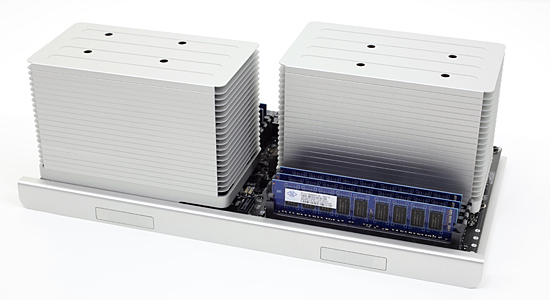
Two towering heatsinks, eight DIMM slots an X58 chipset are the main attractions. Remember all of the hoopla a few pages ago about Turbo Mode? That’s the reason for these beefy heatsinks; there’s actually a fan inside each heatsink, as well as two large fans moving air across the entire board in the case.

The heatsinks have an integrated fan and thermal sensor (black cable)
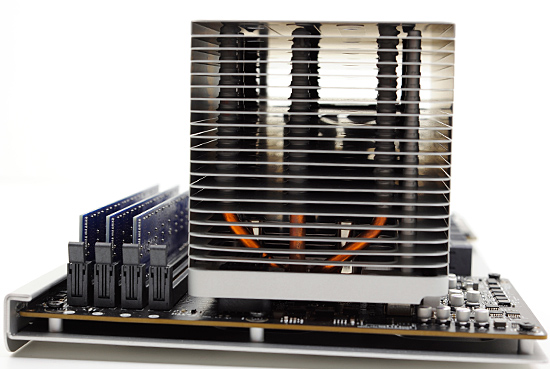
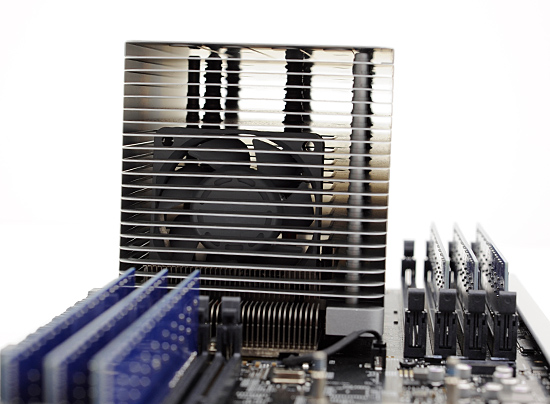
There are four screw holes at the top of the heatsink. Apple actually made removing the heatsinks very easy, all you need is a long 3mm hex key - about 3” long (plus a handle) should suffice.
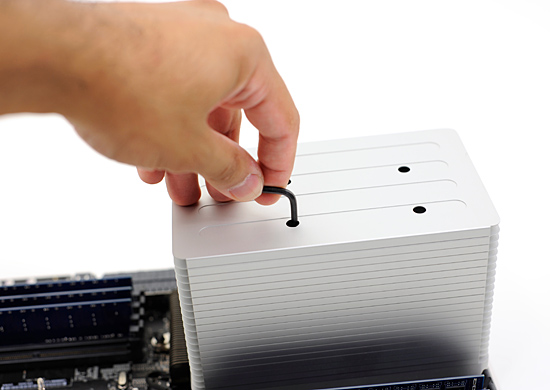
Stick the hex key in any one of the holes, move it around until it grabs, and then unscrew. Rinse and repeat. The screws are attached to the heatsink and spring loaded; you don’t have to physically remove any, just wait until they pop up.
With all four screws removed you can just lift the heatsink straight up. The CPU sockets don’t have clamps, so the chip will most likely lift out of the LGA socket attached to the heatsink.
Carefully twist and pull the CPU until it comes off of the heatsink and you’ll be greeted with the first surprise from Apple: the 8-core Mac Pro ships with lidless Nehalems.
Normally a Core i7 or Xeon processor will look like this:
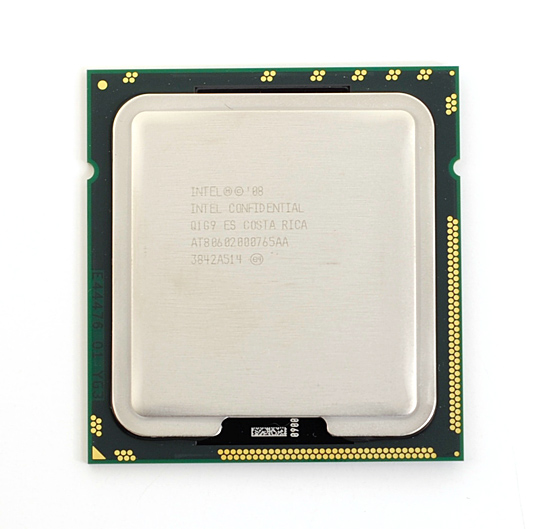
But the 8-core Mac Pro uses specially sourced parts from Intel that have no integrated heat spreader (IHS):

No lid, all Nehalem.
This is obviously a cooling play. The IHS is useful in preventing cracked cores from improperly installed heatsinks, but it does make cooling more difficult. With the heatsink flush against the bottom of the Nehalem die, it can remove heat faster from the chip. More efficient cooling results in lower CPU temperatures and lower fan speeds.
The lidless Nehalems are only used in the 8-core version as far as I can tell. The standard quad-core Nehalem Mac Pro uses regular Xeons with an integrated heat spreader.
The lidless Nehalems do provide a challenge: you can’t buy them. You have to buy a standard, lidded Nehalem Xeon and either remove the IHS or leave it intact and hope it works well. The first option isn’t a very good one; while removing a heat spreader isn’t impossible, you do run the risk of destroying your $1400 CPU. The second option, if it works, is the safest route.
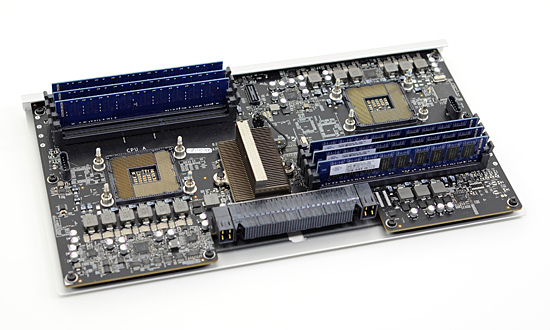
We got a pair of Xeon X5570s and tried to install them, with heat spreaders and all, in our 8-core Mac Pro. Simply pull one chip out, replace it, apply thermal grease, remount the heatsink and screw it back in...or so we thought.
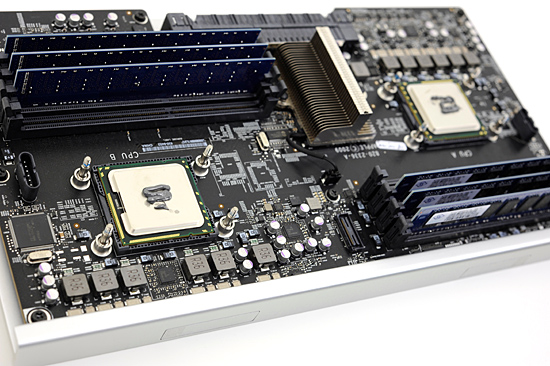
The lidless Nehalems were out, the new lidded processors should work - they should just be a bit more difficult to cool










58 Comments
View All Comments
analog1 - Thursday, July 16, 2009 - link
Why not run the same benchmarks, like Premier pro cs 4 and Photoshop on a Core i7 PC?I think the results will surprise a low of people. I have sen comparisons done with Protools - a highly threaded proffessional DAW ( Digital Audio Workstation) 8 core nehalem Mac Pro (16 thread) vs an OCed i7 920 (3.6 ghz) and the 920 beat the mac pro by roughly 20%. This is probably due to much higher clock speeds, much higher memmory speeds and bandwidth, and much more efficient OS! (yes Windows XP). All this for about $2000 less.
If display cards had anything to do with this test the price/performance difference would be even higher. This is testing audio processing only.
I think if Anand could take the time and bench an OCed or stock i7 920 vs 8 core mac pro on the apps used with the same content we will all be finally able to throw the mac 'CREATIVITY' marketing slogan out the window for good.
I use macs every other day and am writing this on a mac (dual G5, but still). I also use PCs on a daily basis. all for work no play. I have been doing this for years, and honestly I don't understand why people like macs. they are SIMPLER not BETTER.
OSX has nice animation, and the iPhone is cool. Bravo Apple. Now can we please get a REAL bench for these apps PC vs Mac so we can all go to sleep knowing we actually do have the best system for $1000, even if it was designed by Antec+Seasonic+Corsair+Termalright+Gigabyte and so on... (and not buy Apple)
tstm - Wednesday, July 15, 2009 - link
What this article deserves, is a slap to Apple because of their memory configurations.The low end Mac Pro comes with four (4) memory slots. That's utterly ridiculous, considering that Nehalem supports triple channel memory. Adding 8GB (4x2GB) of memory will bring the memory bandwidth down somewhat, which is unacceptable for a $2500 machine.
The 8 core version, on the other hand, comes with 8 slots, again not a multiple of 3. With DDR3 SDRAM 4GB sticks being so ridiculously expensive, this makes any larger memory configs for the Mac Pro extremely expensive.
There's one more gripe: The server CPUs Apple uses could use RDIMM or UDIMM memory, which is _a LOT_ cheaper than normal DDR3 SDRAM mostly because it's being used in server configurations where it's not unheard of to have 192GB of ram in a machine, no one wants to pay gazillions for the 8GB DDR3 SDRAM sticks that would require.
Buying a server board with 18 RDIMM/UDIMM memory slots for building a similar workstation as the Mac Pro would be an insanely much better solution for anything that requires memory to operate (running multiple test VMs for instance). I think it's pretty sad that apple is not even trying to cater professionals with this "Mac Pro" toy they've built. I really would like to use an apple computer, but these drawbacks made me use a Hackintosh, which has its own drawbacks.. but for workstation use none are so bad when you compare it to the Mac Pro.
fmaste - Tuesday, July 14, 2009 - link
So, this is a good computer after changing the CPU and buying a second video card. How could someone say that this is OK? I don't think that Apple notebooks are expensive, you really get a premium notebook with all premium components, but this seems very overpriced.I like Apple and OSX a lot, but the case and interior design don't cost that much, you can build your own computer for much less, and with one of the awesome cases reviewed here at anandtech.
Also, what about GPU performance and comparison?
Third party GPUs? How? Expansion slot available?
Power, Noise, heat?
What about Boot Camp?
Type of memory?
And I would really appreciate a price and performance comparison with other workstations and what you can build for that money.
Tutor - Thursday, July 16, 2009 - link
This is my dream machine at post #10. I call it MyHackedUpMac.Tutor - Thursday, July 16, 2009 - link
http://forums.macrumors.com/showthread.php?t=71393...">http://forums.macrumors.com/showthread.php?t=71393...BoboGO - Tuesday, July 14, 2009 - link
Two 3.2GHz Quad-Core Intel Xeon "Nehalem" processors!12GB (6 x 2GB) DDR3 1333 (PC3 10600) memory
NVIDIA GeForce GTX 285 with 2GB GDDR3 memory
8X Blu-Ray Writer
250GB Vertex SATA II MLC Internal Solid state disk (SSD)
1TB SATA 3.0Gb/s hard drive
22X DVD/CD double-layer writer with LightScribe support
X-Fi Titanium Fatal1ty Champion Series 7.1 Channels PCI-Express Sound Card
Thermaltake Xaser VI Black Aluminum Computer Case
Sorry, no monitor included.
Ships: 3 days
Total Cost: $5833.00
vailr - Tuesday, July 14, 2009 - link
Re:"I couldn’t wait any longer and I ended up building a Hackintosh based on Intel’s Core i7. Literally a day after I got it up and running, Apple announced the new Nehalem-EP based Mac Pro."
More details, please.
List of parts used & cost, the method used for installing OSX, & a "bang for buck" comparison with Apple's equivalent machine.
TIA
erple2 - Wednesday, July 15, 2009 - link
That's a good question. Also, how much time did you spend getting the Hackintosh up and running?And for the final question, how much do you believe your time to be worth? I know how much I am paid per hour at my job. It doesn't take that long of hassling with a Hackintosh to make it worth my while to just buy the Mac instead. Include time spent when I go to update the OS and have to research which updates will work with my particular Hackintosh, plus those times that I accidentally do an update that I didn't fully research and hosed my setup. Oh, and make sure that I factor in some time for when my soundcard just didn't quite work right after a reboot...
Ultimately, it boils down to the triplet: Time, Money, Productivity - pick two.
Baked - Tuesday, July 14, 2009 - link
Wait, people actually upgrade their Mac? I thought they just buy a new one when it gets real slow. At least that's what happens at the places I worked at. Buy a brand new Mac, use it for a few years, buy a new one and send the old one to surplus. We do buy memory from micron instead of doing it through Apple though.xz4gb8 - Tuesday, July 14, 2009 - link
You said, "Between the high cost of the adapter and the high likelihood of problems, I’d suggest simply getting another video card if you want to have multiple 30” displays connected to your Mac Pro. Apple sells the GeForce GT 120 for $150 as an upgrade option, and at least with it each 30” display will be driven by its own frame buffer, which should make for smoother Exposé and Dashboard operation."If you allow non-Apple displays, many higher-end displays have DisplayPort connectors - see the Dell 3008WFP, for example. A mini-DP to DP cable is under $20 including shipping.
The mini-DP to DVI adapter is too clunky and tends to unplug itself. The mini-DP to HDMI adapter is under $20 and is slightly less clunky. Neither are as elegant as the mini-DP to DP cable.
I make no claims for the Video card performance.